How to Portion Meal Prep Like a Pro
Tired of guessing? Learn how to portion meal prep accurately for your health goals. Get expert tips, tools, and tricks for perfect portions every time.
Ready to Simplify Your Meal Planning?
Get personalized meal plans and grocery lists automatically matched to your macro targets.
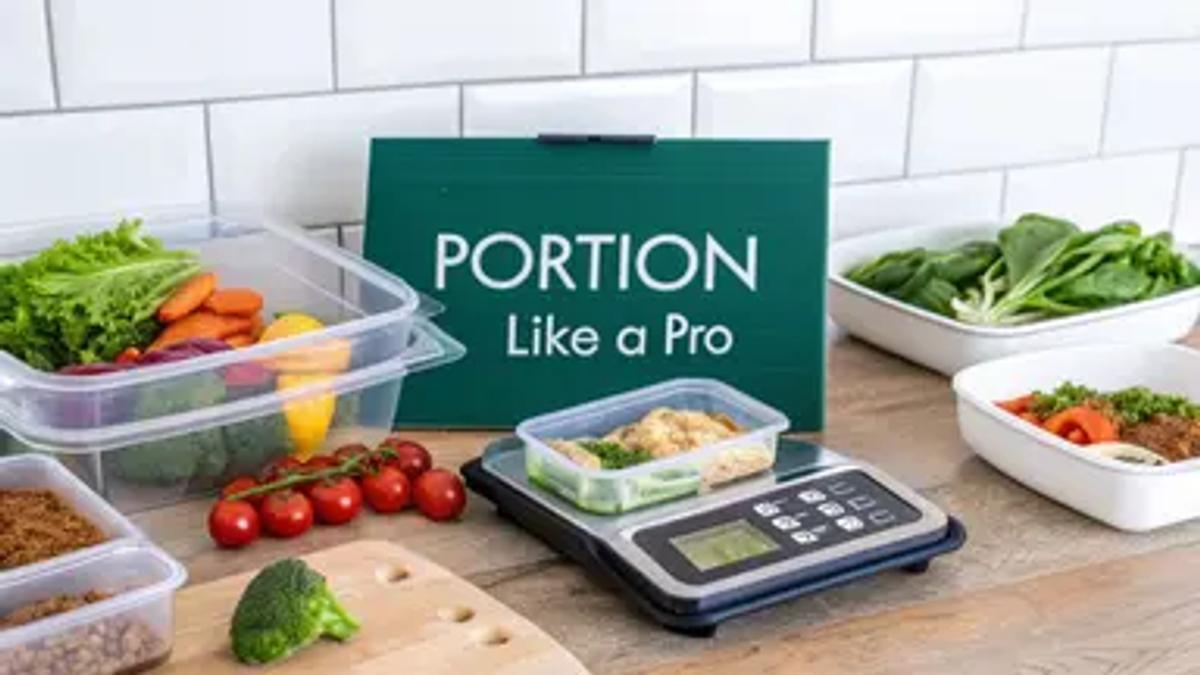
How to Portion Meal Prep Like a Pro
Alright, let's ditch the robotic tone and give this section a human touch. Here’s a rewrite that sounds like it came from a seasoned meal prep pro.
***
So, you want to learn how to portion your meal prep? It’s pretty straightforward, really. It all boils down to one simple habit: actually measuring your food with a trusty food scale before you pack it up. This is what transforms a big batch of cooking into a precision-led system, ensuring you nail your nutrition goals, whether you're trying to drop a few pounds, build muscle, or just stop hitting that 3 PM wall.
Why Accurate Portions Are Your Meal Prep Superpower
Let's be real for a second. Meal prep isn't just about cooking a mountain of chicken on a Sunday. It’s about creating a system that sets you up for success. And the number one mistake I see people make? Eyeballing their portions.
That slightly-too-generous scoop of rice or that "one extra" piece of chicken might not feel like a big deal at the moment. But day after day, those little extras add up, and they can completely derail your progress over a week. Accurate portioning is the secret weapon that turns your meal prep from a simple convenience into a powerful tool for your health. It’s the difference between guessing and knowing.
From Guesswork to Guaranteed Results
When you take a few extra minutes to weigh and divide your meals, you gain total control over what you're eating. This isn't just for elite athletes; it's a game-changer for anyone with a goal.
- Trying to manage your weight? Precise portions mean you can stick to your calorie target without feeling like you're starving.
- Looking to build muscle? You can guarantee you're getting the exact amount of protein and carbs your body needs to recover and grow.
- Just want more energy? Balancing your meals properly stops those wild blood sugar swings that leave you feeling drained.
This is exactly why the meal prep industry is exploding. The market was worth around USD 5.68 billion and is expected to rocket to USD 12.89 billion by 2033. Why? Because people are realizing how powerful managing their calories and macros truly is. You can read more about meal prep market trends to see just how big this movement has become.
The real magic of precise portioning is accountability. You’re cutting out the guesswork and creating a direct link between the work you do in the kitchen and the results you see and feel.
The Everyday Wins You'll Notice Right Away
Getting your portions right does more than just help you hit your fitness targets; it brings some seriously practical benefits to your daily life. You’ll be shocked at how much less food you waste when every last bit of rice and broccoli has a designated container. Naturally, this ends up saving you a decent chunk of change on your grocery bill, too.
Ultimately, it’s about shifting your mindset. You stop hoping you're on track and start knowing you are, making every single meal a confident step toward where you want to be.
Building Your Ultimate Portioning Toolkit
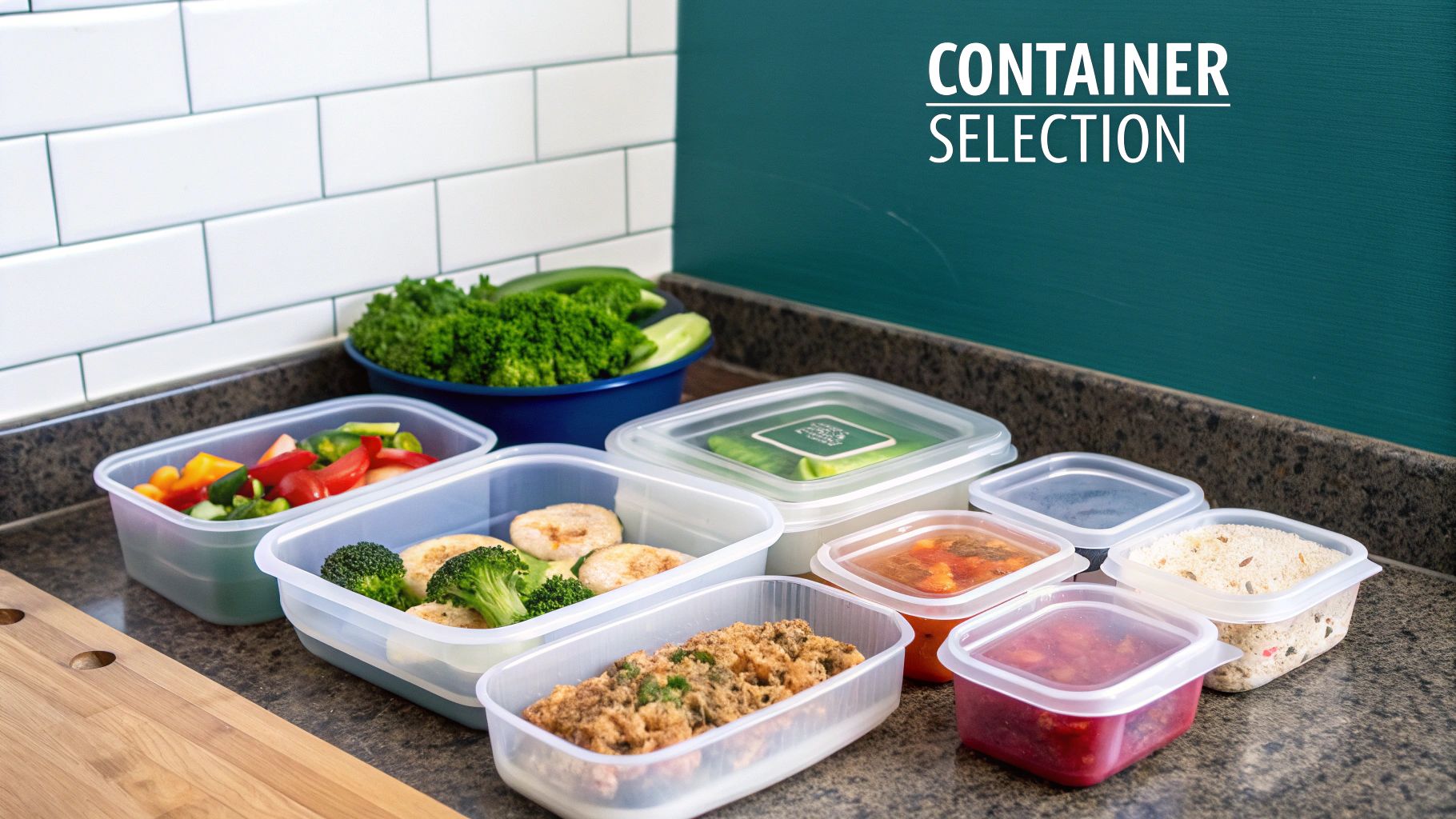
Let's be real. You wouldn't try to build a bookshelf with just your bare hands, right? So why wing it with your meal prep? Getting the right gear isn't about loading up on useless gadgets; it's about making a few smart buys that turn a tedious chore into a smooth, accurate, and maybe even enjoyable process.
Your absolute, must-have, ride-or-die tool is a digital food scale. Guessing portions is the number one saboteur of any nutrition plan. A scale is your source of truth. It’s the difference between thinking you’re eating 150 grams of chicken and knowing you are. It's the fastest way to truly learn what proper serving sizes look and feel like.
Key Takeaway: A food scale isn't just a tool; it's a teacher. It closes the gap between 'I think this is right' and 'I know this is right,' giving you total control over your nutrition.
Get the Right Gear: Containers and Measuring Tools
Once you’ve got your scale, a few other key players will make your life a whole lot easier. Think of them as the trusty sidekicks that help your scale do its best work.
- Meal Prep Containers: Ah, the great glass vs. plastic debate. Here’s my take: you need both. Glass containers are fantastic for reheating and never stain, but they're heavy. High-quality, BPA-free plastic is light and perfect for your work bag, but can sometimes hold onto smells. I keep a mix—glass for home-based meals and plastic for anything on the go.
- Measuring Cups and Spoons: Your scale is the undisputed champ for solids like chicken or sweet potatoes. But for liquids, sauces, and post-cooking grains like rice or quinoa, measuring cups are your best friend. A good set makes scooping out that half-cup of Greek yogurt or tablespoon of dressing quick and painless.
This need for precise, easy portioning is exactly why the meal kit industry is exploding. Companies have built entire businesses on sending people perfectly measured ingredients, a trend you can learn more about by checking out data on how the meal kit industry is growing.
To make it even simpler, here are the absolute essentials I recommend for anyone serious about portion control.
Your Essential Portion Control Toolkit
| Tool | Best For | Pro-Tip |
| Digital Food Scale | Weighing solid foods like protein, vegetables, and fruit. The ultimate tool for accuracy. | Place your container on the scale and hit the "tare" button to zero it out before adding food. No math required! |
| Meal Prep Containers | Storing and transporting your perfectly portioned meals. | Use painter's tape and a marker to label containers with the contents and date. It peels off easily with no sticky residue. |
| Measuring Cups | Portioning cooked grains, legumes, and liquids like milk or broth. | For sticky ingredients like honey or nut butter, lightly spray the cup with cooking spray first. It'll slide right out. |
| Measuring Spoons | Measuring small amounts of high-calorie items like oils, dressings, seeds, and spices. | Don't just scoop; use a knife to level off the top for a perfectly accurate measurement. |
With these few items in your kitchen, you're not just prepping food—you're setting yourself up for consistent success.
A Simple Formula for Building Balanced Meals
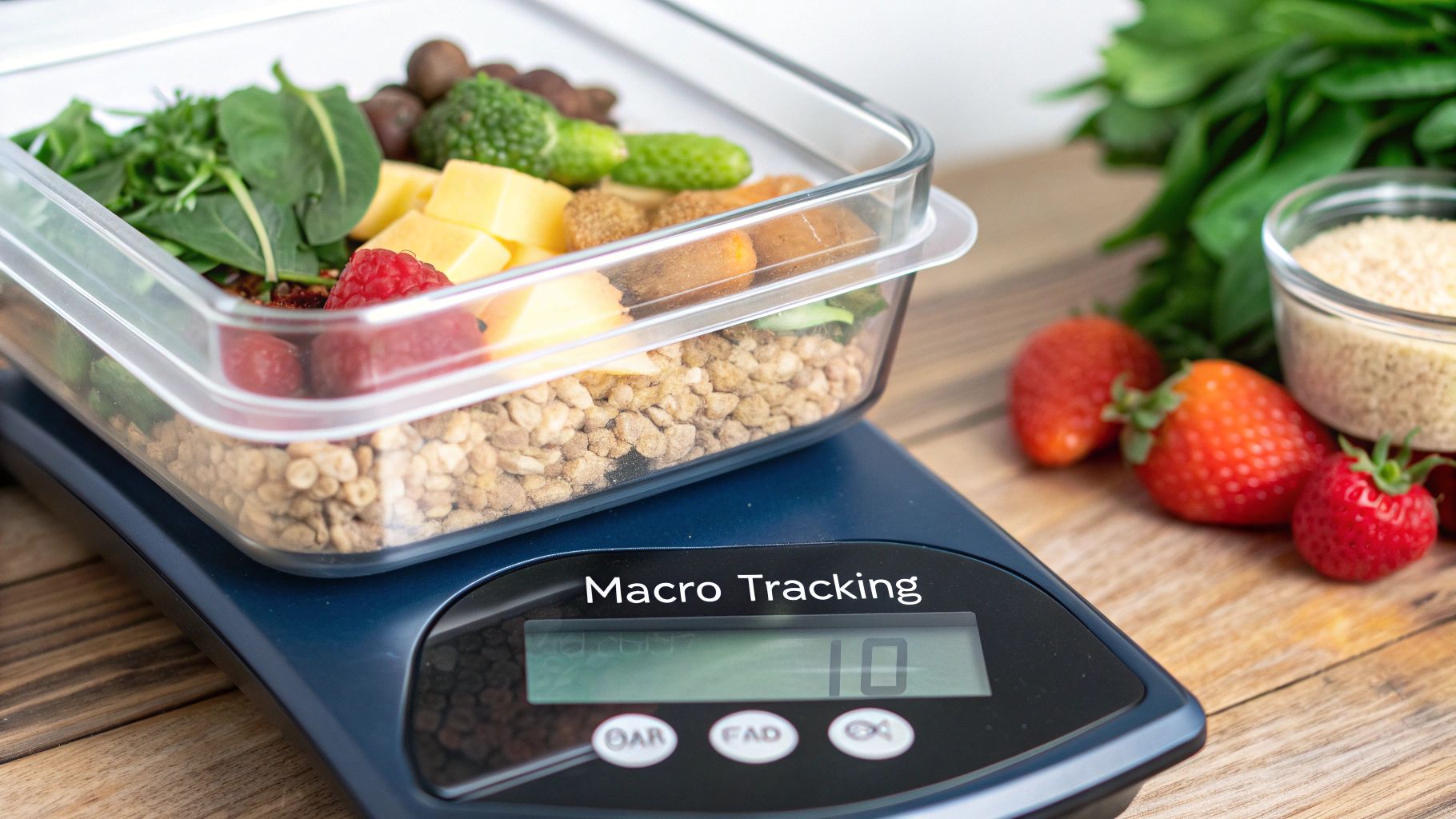
Alright, you've got your tools, your food scale is staring back at you, and you're ready to go. So, what exactly are we putting in these containers? Let's ditch the overcomplicated nutrition dogma for a second. Building a balanced, perfectly portioned meal is way easier than you've been led to believe.
The real trick is crafting meals that actually keep you full, match your health goals, and—most importantly—don’t make you feel like you’re stuck in a flavorless loop. We’re going to walk through two of my favorite, battle-tested methods for getting this done.
The Plate Method: A Visual Shortcut
The absolute simplest place to start is with the Plate Method. Seriously, it’s a no-fuss visual guide that just plain works. Picture your meal prep container as a plate and mentally slice it up.
- 50% Non-Starchy Veggies: This is half the real estate. We're talking broccoli, spinach, bell peppers, zucchini, or a heaping pile of mixed greens. They’re bulky, packed with nutrients, and low in calories, which is the secret to feeling satisfied.
- 25% Lean Protein: Dedicate this quarter to the stuff that builds muscle and crushes hunger. Think grilled chicken, flaky fish, lean ground beef, or a block of seasoned tofu.
- 25% Complex Carbs: The last quarter is for your fuel. Fill it up with quality energy sources like quinoa, brown rice, sweet potatoes, or whole-wheat pasta.
This simple ratio is a game-changer. It gives you a reliable blueprint for building a nutritionally solid meal without getting lost in the weeds of counting every last gram.
Think of this as your foolproof foundation. It’s not a rigid, unbreakable law but a flexible guideline that ensures you get a powerful mix of nutrients in every single meal. That's the core of learning how to portion meal prep effectively.
Your Hand: The Ultimate On-the-Go Portioning Tool
What happens when you’re out in the wild, far from your trusty kitchen scale? This is where learning to use your hand as a measurement tool becomes a legit superpower. It’s surprisingly accurate for eyeballing portion sizes when you’re at a restaurant or just need a quick sanity check.
Here’s the breakdown:
- Palm: The size of your palm (minus the fingers) is a great stand-in for a single serving of protein, about 3-4 ounces.
- Cupped Hand: What you can fit in your cupped hand is roughly one serving of carbs, or about 1/2 cup.
- Fist: Your closed fist is a dead ringer for a serving of vegetables, which comes out to around 1 cup.
- Thumb: From the tip to the base, your thumb is about one tablespoon—perfect for measuring out fats like nut butter or oils.
This technique is a lifesaver for staying on track when you can't weigh everything. It helps you make smart choices no matter where you are, cementing the great habits you’re building at home.
Your Assembly Line for Perfect Portions
Alright, this is where the magic happens. All that planning and cooking is about to pay off as you create your perfectly portioned meals. The goal here is to set up a smooth, chaos-free workflow that makes you feel like a pro running a well-oiled assembly line in your own kitchen. It's not just about cooking; it's about having a smart, repeatable process.
First thing's first: embrace the classic chef's technique of mise en place—a fancy way of saying "get all your stuff ready." Before you even think about dishing things out, have all your cooked components cooled down and ready to go. Line up your containers, lids off, with your food scale nearby and set to zero. This simple setup completely eliminates that frantic scramble for a missing lid or a clean spoon mid-process.
Master Batch Weighing for Flawless Consistency
Here’s a move I swear by that guarantees every single meal is a perfect clone of the last. You're going to weigh your main components in bulk before you start dividing them up.
Let's say you've cooked a big batch of chicken breasts. Just grab a big empty bowl, place it on your scale, and hit the 'tare' button to zero it out. Now, pile all the cooked chicken into the bowl. If the total weight is 1,000 grams and you're making five meals, a little quick math (1,000 / 5) tells you that each container gets exactly 200 grams of chicken. Trust me, this is way faster and more accurate than weighing each little portion one by one.
This handy visual breaks down how to balance your container at a glance.
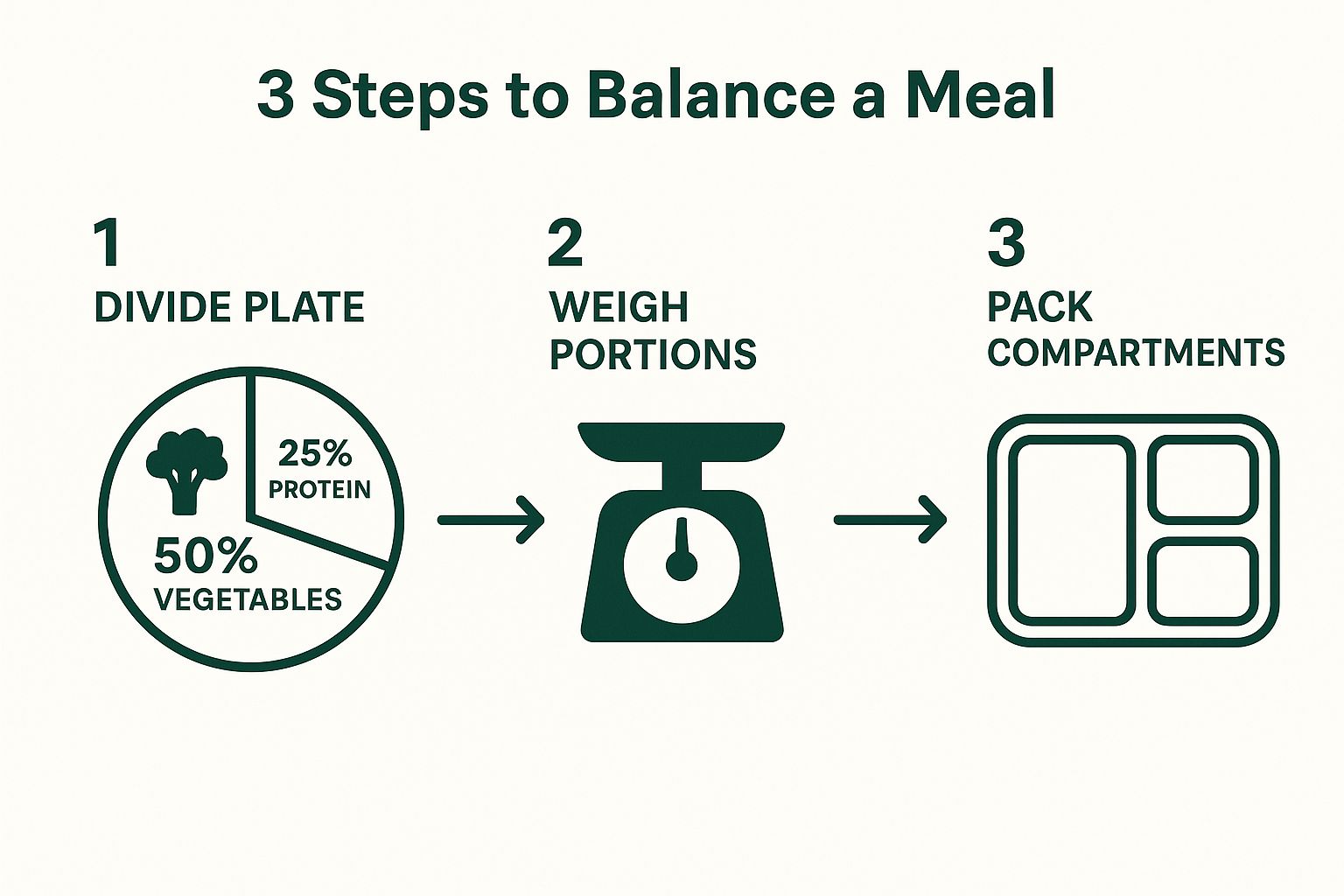
This simple 50-25-25 rule is a fantastic mental shortcut for building a balanced plate before you even pull out the food scale.
This systematic approach is exactly why pre-portioned meal solutions have absolutely exploded in popularity. The number of global meal kit users more than doubled from 9.4 million to 19.8 million in just four years! It's clear proof that people are hungry for this kind of structure. You can dive deeper into these pre-portioned meal kit trends to see how big this shift has become.
Let's Walk Through a Real-World Example
Okay, let's bring this to life. Picture this: you've just finished prepping a batch of grilled chicken, roasted broccoli, and some delicious sweet potato cubes. Here’s how your assembly line would look in action:
- Protein Goes In First. Using that batch-weighing method we just talked about, you'll divide your chicken evenly among your five containers.
- Next Up, Carbs. For things like rice, quinoa, or potatoes, an ice cream scoop with a trigger release is an absolute game-changer. It gives you a surprisingly consistent portion every single time. One level scoop, right into each container. Easy.
- Veggies Fill the Gaps. Finally, fill the rest of the space with that roasted broccoli. Since most veggies are pretty low in calories, you can be generous here to make sure your meals are satisfying and keep you full.
By creating a repeatable workflow—protein, carb, veggie, repeat—you start to build muscle memory. Your Sunday prep session gets faster and more accurate every single week, turning what felt like a chore into a seriously satisfying ritual.
Common Meal Prep Mistakes to Avoid
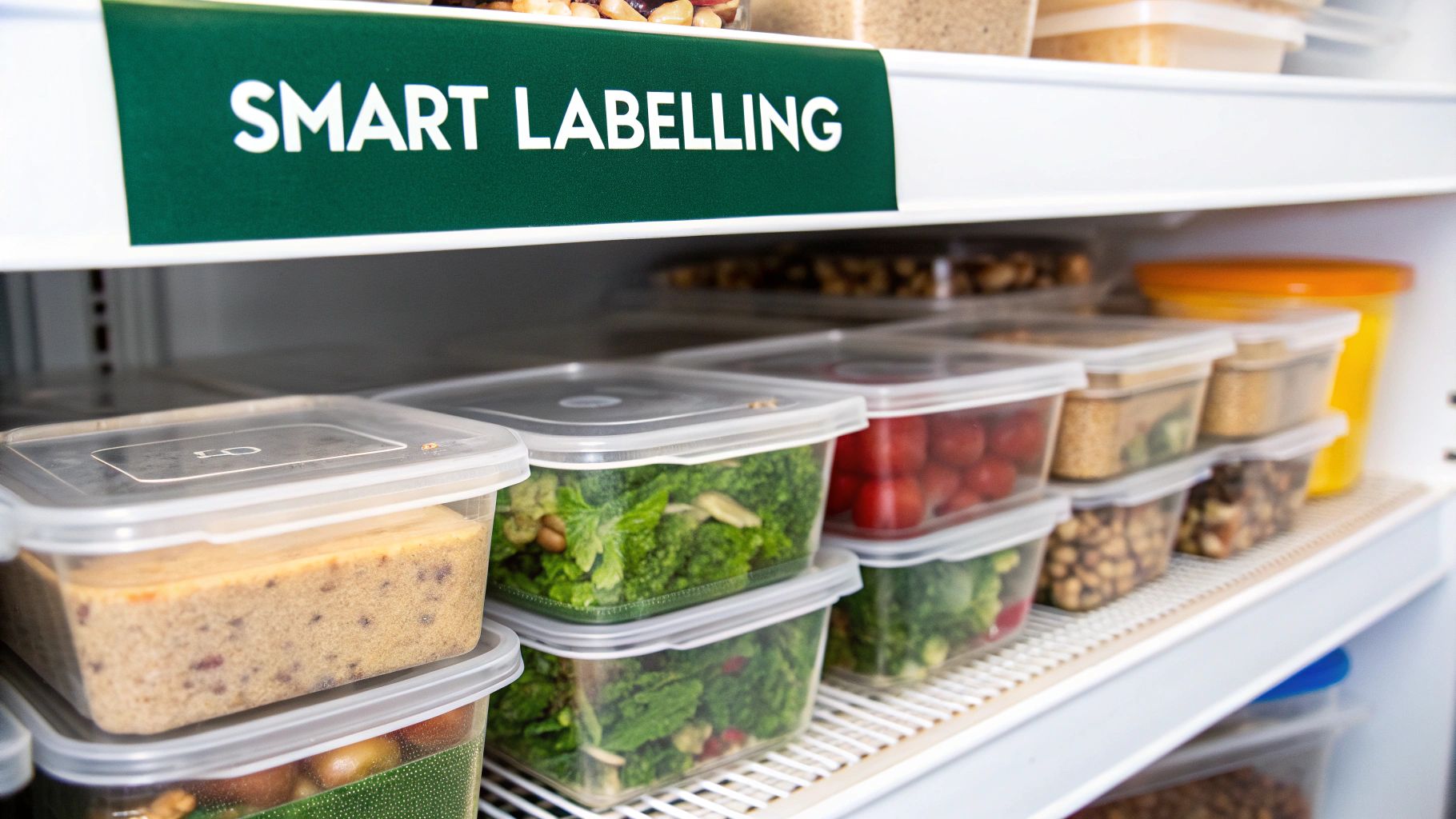
Look, even the most seasoned meal preppers have faced defeat. You can get your portions right down to the last gram, but a few simple missteps can totally wreck all your Sunday efforts. Let's talk about the common traps that can sabotage your week of perfectly planned meals.
The biggest mistake I see? It's something I call "portion distortion," and it’s sneakier than you think. You might have painstakingly weighed out 150 grams of chicken and a perfect half-cup of quinoa, but then you go and drown it in a "healthy" dressing or a few generous glugs of olive oil. These additions seem harmless, but they can secretly pile hundreds of calories onto what was supposed to be a perfectly portioned meal.
The most overlooked part of portioning isn't the main ingredients; it's the high-calorie extras. A tablespoon of olive oil has around 120 calories—ignoring it is like ignoring an entire snack.
This is where so many people go wrong. You have to measure your oils, dressings, sauces, and nuts. A simple set of measuring spoons is your best friend in the fight against these sneaky calorie bombs.
Dodging the Soggy Meal Syndrome
Alright, let's talk about the second major pitfall: the dreaded soggy meal. Honestly, there's nothing more soul-crushing than opening your container on Wednesday to find a sad, wilted mess. That crisp salad you were looking forward to is now a watery swamp, and your beautiful roasted veggies have gone totally limp.
The good news is that preventing this is all about strategy.
- Store Dressings Separately: This is non-negotiable. Never, ever dress your salads ahead of time. Pop your vinaigrette into a tiny, separate container and toss it all together right before you dig in.
- Layer Like a Pro: When you're packing salads in a jar or container, think like an architect. Put the sturdiest stuff on the bottom (think chickpeas, cucumbers) and save the delicate greens for the very top.
- Pick Resilient Ingredients: Let’s be real, some foods are just tougher than others. Roasted root veggies like carrots and sweet potatoes, hearty greens like kale, and sturdy grains like quinoa are your best bets for meals you'll be eating later in the week.
By sidestepping these classic blunders, you can make sure that your last meal of the week is just as fresh, delicious, and perfectly portioned as your first.
Frequently Asked Meal Prep Questions
Alright, so you’ve got the basics down. But as you get into a real meal prep groove, the little questions start popping up. The "wait, should I have weighed that before I cooked it?" moments. Let's clear up those common hurdles right now so you can keep your momentum going.
This is where we tackle those nitty-gritty details that turn good meal prep into great meal prep.
Should I Weigh Food Raw or Cooked?
Ah, the classic debate. I get this one all the time, and the answer is crucial for getting your numbers right. For the most accurate tracking, you should always weigh protein like chicken, beef, or fish when it's raw.
Here’s why it matters so much: meat loses a ton of water weight when you cook it. That 150-gram raw chicken breast you started with might only weigh 110 grams after it hits the grill. If you weigh it cooked, you're short-changing your protein and calorie count significantly.
Now, for things that soak up water, like rice, pasta, or beans, you’ve got a bit more flexibility. You can either weigh them after they’re cooked (which is often easier) or weigh them dry and use the "dry" nutrition info. The key is just to be consistent.
My Two Cents: Raw weight is the gold standard for protein, period. For carbs, cooked is usually more practical. Just pick one method and stick to it so your tracking stays consistent week after week.
How to Adjust Portions for Different Goals
Your portion sizes are not one-size-fits-all. They're dials you can turn up or down depending on your goal. Let's take the same basic meal—say, chicken, quinoa, and broccoli—and tweak it for different results.
- For Weight Loss: You want to feel full without racking up calories. Keep your protein serving standard, but go wild with the non-starchy veggies. I mean, really pack them in there. This fills up the container and your stomach. Be mindful with the carbs—a small, level scoop is plenty.
- For Muscle Gain: This is where you fuel the machine. You'll want a bigger portion of that lean protein to help your muscles recover and grow. And don't be shy with the complex carbs! A generous serving will power your workouts and restock your energy stores.
How Do I Stop My Meals from Getting Boring?
Flavor fatigue is the enemy of consistency. I've seen it derail so many people. But the secret isn't making five completely different, complicated meals. It's all about mastering simple variations.
Prep your main ingredients—your chicken, your quinoa, your roasted veggies—with just basic seasonings like salt and pepper. Think of them as a blank canvas. Then, each day, you get to be an artist.
- Monday: Go Southwest. Add a spoonful of salsa, some black beans, and a sprinkle of fresh cilantro.
- Tuesday: Give it an Asian twist. Drizzle on a bit of soy-ginger dressing and top with sesame seeds.
- Wednesday: Hello, Mediterranean. Mix in a dollop of pesto and some halved cherry tomatoes.
This simple trick makes it feel like you’re eating something new every day, even when the core components are the same. It's a total game-changer for sticking with it long-term.
---
Ready to make meal planning and grocery shopping feel like a cheat code? Meal Flow AI uses smart technology to create personalized meal plans and then zaps the shopping list right over to Instacart for you. It streamlines your entire week. Discover a smarter way to plan and shop at https://mealflow.ai.